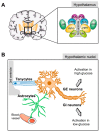Dissecting the Brain/Islet Axis in Metabesity
- PMID: 31072002
- PMCID: PMC6562925
- DOI: 10.3390/genes10050350
Dissecting the Brain/Islet Axis in Metabesity
Abstract
The high prevalence of type 2 diabetes mellitus (T2DM), together with the fact that current treatments are only palliative and do not avoid major secondary complications, reveals the need for novel approaches to treat the cause of this disease. Efforts are currently underway to identify therapeutic targets implicated in either the regeneration or re-differentiation of a functional pancreatic islet β-cell mass to restore insulin levels and normoglycemia. However, T2DM is not only caused by failures in β-cells but also by dysfunctions in the central nervous system (CNS), especially in the hypothalamus and brainstem. Herein, we review the physiological contribution of hypothalamic neuronal and glial populations, particularly astrocytes, in the control of the systemic response that regulates blood glucose levels. The glucosensing capacity of hypothalamic astrocytes, together with their regulation by metabolic hormones, highlights the relevance of these cells in the control of glucose homeostasis. Moreover, the critical role of astrocytes in the response to inflammation, a process associated with obesity and T2DM, further emphasizes the importance of these cells as novel targets to stimulate the CNS in response to metabesity (over-nutrition-derived metabolic dysfunctions). We suggest that novel T2DM therapies should aim at stimulating the CNS astrocytic response, as well as recovering the functional pancreatic β-cell mass. Whether or not a common factor expressed in both cell types can be feasibly targeted is also discussed.
Keywords: T2DM; astrocytes; inflammation; metabesity; obesity; pancreatic islet.
Conflict of interest statement
The authors declare no conflicts of interest.
Figures


References
-
- IDF Diabetes Atlas. [(accessed on 9 January 2019)]; Available online: http://www.diabetesatlas.org.
-
- van Greevenbroek M.M., Schalkwijk C.G., Stehouwer C.D. Obesity-associated low-grade inflammation in type 2 diabetes mellitus: Causes and consequences. Neth. J. Med. 2013;71:174–187. - PubMed

